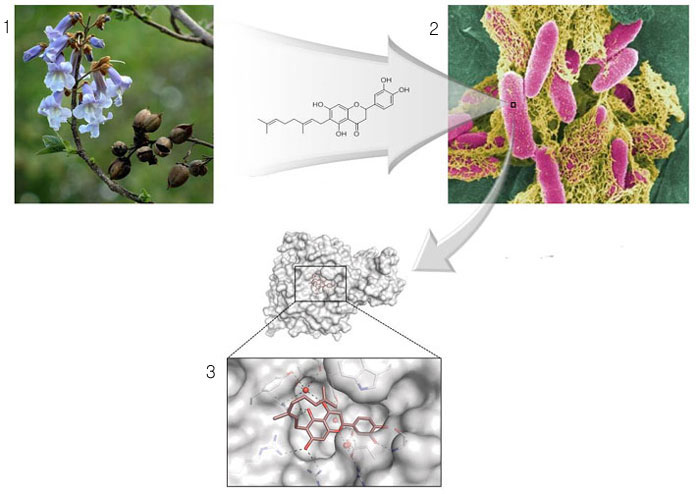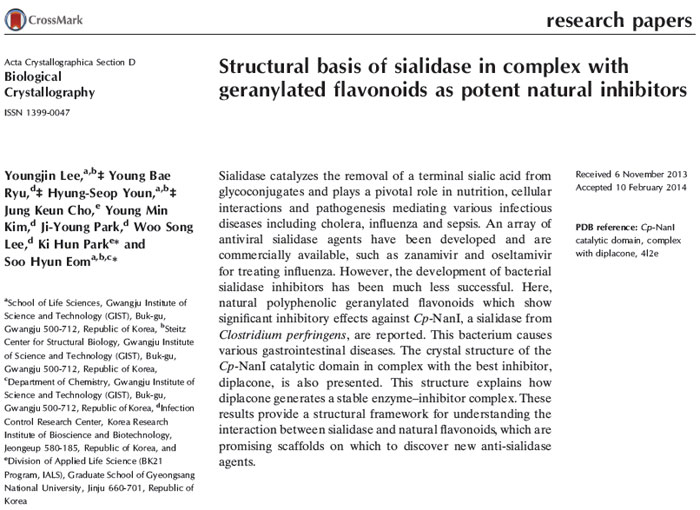-
 Korea.net's 24-hour YouTube channel
Korea.net's 24-hour YouTube channel- NEWS FOCUS
- ABOUT KOREA
- EVENTS
- RESOURCES
- GOVERNMENT
- ABOUT US
A recent study has proven that flavonoids, a natural food coloring extracted from the empress tree, constrains the activation of neuraminidase, a protein believed to cause avian influenza and other diseases.
The results of the research were recently announced by a group of scientists led by Profesor Eom Soo Hyun of the Gwangju Institute of Science and Technology and Profesor Park Ki Hun of Gyeongsang National University.

Flavonoids are a natural food coloring that can be found in many plants and work as antioxidants. Neuraminidase is a protein essential for the infection and proliferation of viruses and bacteria that can cause various diseases, such as bird flu or peritonitis.
The researchers tested the way in which diplacone, a type of flavonoid, combines with neuraminidase to constrain the enzyme functions at the atomic level.

Researchers predict that this study will give a clue to developing new anti-bacterial medicines, as it has proved that flavonoids can effectively restrict neuraminidase.
Controversy has been raised over the efficacy and side effects of existing neuraminidase restrainers, such as Tamiflu which is usually prescribed to flu patients. The newly-proven flavonoid composite structure, however, has neither toxic chemicals nor functions on pre-existing neuraminidase already in humans. Therefore, it is expected to have a low possibility of side effects, as it is a natural substance.

The research results were introduced in the May edition of Acta Crystallographica Section D: Biological Crystallography, an international publication that covers the crystal structure sector of biology.
By Yoon Sojung
Korea.net Staff Writer
arete@korea.kr
The results of the research were recently announced by a group of scientists led by Profesor Eom Soo Hyun of the Gwangju Institute of Science and Technology and Profesor Park Ki Hun of Gyeongsang National University.

Profesor Eom Soo Hyun of the Gwangju Institute of Science and Technology (left), Profesor Park Ki Hun of Gyeongsang National University
Flavonoids are a natural food coloring that can be found in many plants and work as antioxidants. Neuraminidase is a protein essential for the infection and proliferation of viruses and bacteria that can cause various diseases, such as bird flu or peritonitis.
The researchers tested the way in which diplacone, a type of flavonoid, combines with neuraminidase to constrain the enzyme functions at the atomic level.

Researchers prove through a test that diplacone, a flavonoid extracted from the empress tree (picture No. 1), constrains neuraminidase (picture No. 2). Based on the results, they release a multi-dimensional composite structure of neuraminidase and flavonoid at an atomic level (picture No. 3).
Researchers predict that this study will give a clue to developing new anti-bacterial medicines, as it has proved that flavonoids can effectively restrict neuraminidase.
Controversy has been raised over the efficacy and side effects of existing neuraminidase restrainers, such as Tamiflu which is usually prescribed to flu patients. The newly-proven flavonoid composite structure, however, has neither toxic chemicals nor functions on pre-existing neuraminidase already in humans. Therefore, it is expected to have a low possibility of side effects, as it is a natural substance.

The May edition of Acta Crystallographica Section D: Biological Crystallography introduces the new findings on flavonoids.
The research results were introduced in the May edition of Acta Crystallographica Section D: Biological Crystallography, an international publication that covers the crystal structure sector of biology.
By Yoon Sojung
Korea.net Staff Writer
arete@korea.kr
Most popular
- China warmly welcomes first Korea-born giant panda Fu Bao
- First hearing-impaired K-pop act hopes for 'barrier-free world'
- Novelist Hwang's 'Mater 2-10' shortlisted for Int'l Booker Prize
- Expats could account for 7% of population in 20 years: report
- Nat'l Fire Agency picks 137 elite staff for deployment abroad













